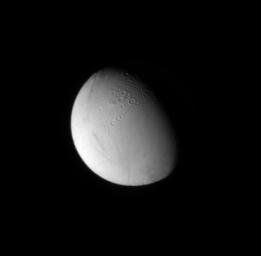
|
Smooth and Rough Enceladus
- Click the image above for a larger view
- Full-Res JPEG (369 x 362) (4.2 kB)
- Full-Res TIFF (369 x 362) (133.9 kB)
Caption:
The Cassini spacecraft looks down at craters near the north pole of Enceladus.
Cratered surfaces on solar system moons indicate older terrains, while smooth surfaces are generally younger, and therefore indicative of processes which eliminated the craters. See PIA08353 to learn more about the true nature of these surfaces and the processes at work on this geologically active moon.
The moon's north pole lies on the terminator to the right of the craters seen in this image. Lit terrain seen here is on the anti-Saturn side and trailing hemisphere of Enceladus (504 kilometers, 313 miles across).
The image was taken in visible light with the Cassini spacecraft narrow-angle camera on July 11, 2009. The view was obtained at a distance of approximately 472,000 kilometers (293,000 miles) from Enceladus and at a Sun-Enceladus-spacecraft, or phase, angle of 57 degrees. Image scale is 3 kilometers (2 miles) per pixel.
Background Info:
The Cassini-Huygens mission is a cooperative project of NASA, the European Space Agency and the Italian Space Agency. The Jet Propulsion Laboratory, a division of the California Institute of Technology in Pasadena, manages the mission for NASA's Science Mission Directorate, Washington, D.C. The Cassini orbiter and its two onboard cameras were designed, developed and assembled at JPL. The imaging operations center is based at the Space Science Institute in Boulder, Colo.
For more information about the Cassini-Huygens mission visit http://saturn.jpl.nasa.gov/ . The Cassini imaging team homepage is at http://ciclops.org .
Cataloging Keywords:
| Name | Value | Additional Values |
|---|---|---|
| Target | Enceladus | Saturn |
| System | Saturn | |
| Target Type | Satellite | Planet |
| Mission | Cassini-Huygens | |
| Instrument Host | Cassini Orbiter | |
| Host Type | Orbiter | |
| Instrument | Imaging Science Subsystem (ISS) | |
| Detector | Narrow Angle Camera | |
| Extra Keywords | Crater, Grayscale, Visual | |
| Acquisition Date | ||
| Release Date | 2009-10-14 | |
| Date in Caption | 2009-07-11 | |
| Image Credit | NASA/JPL/Space Science Institute | |
| Source | photojournal.jpl.nasa.gov/catalog/PIA11601 | |
| Identifier | PIA11601 | |
